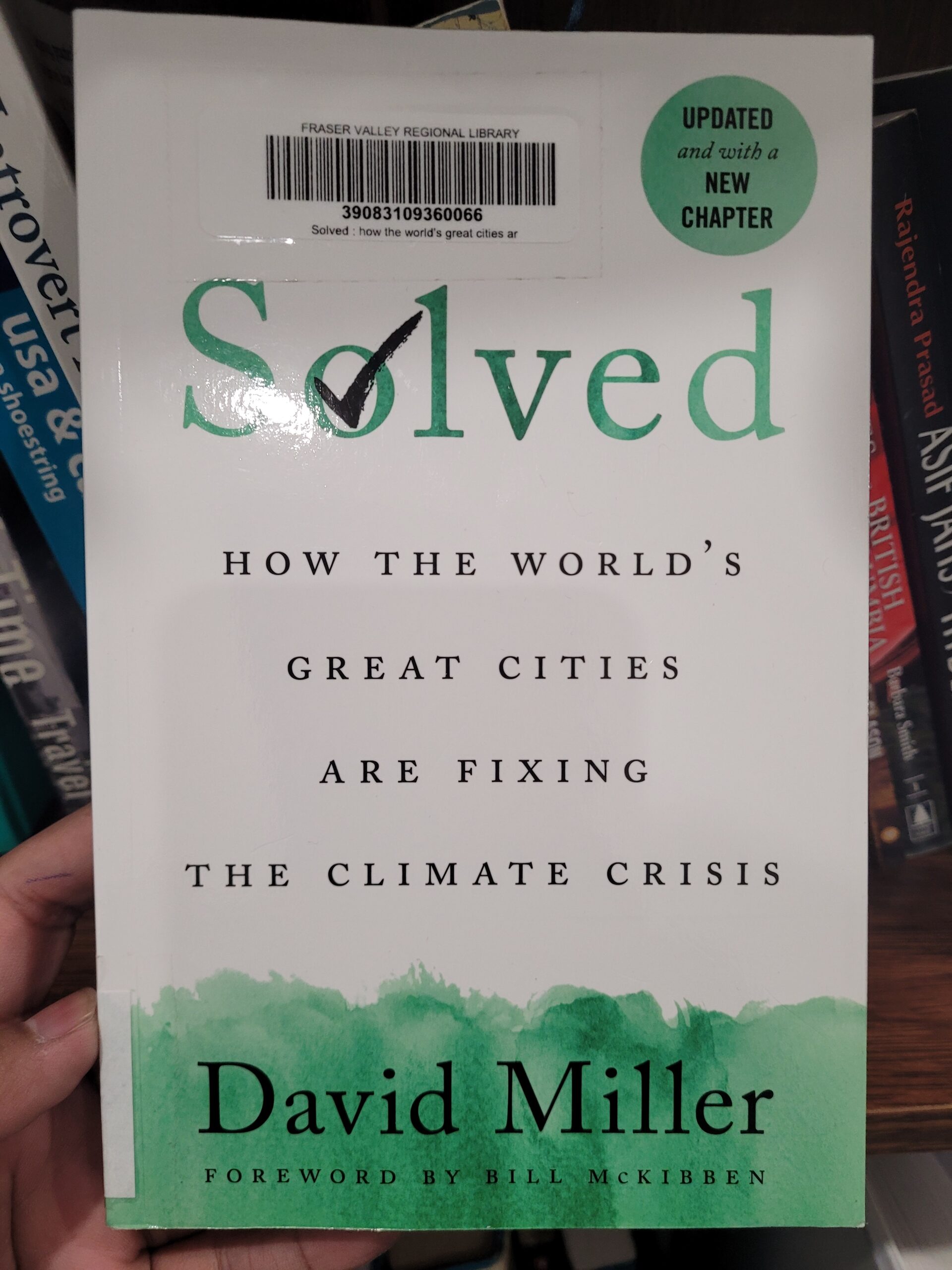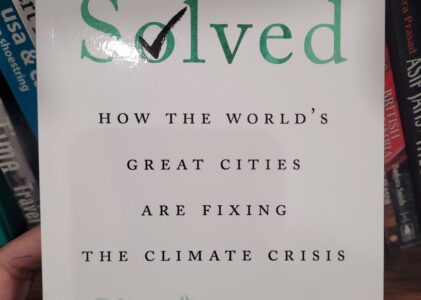
- Name: Solved: How the world’s great cities are fixing the climate crisis
- Author: David Miller
- Genre: Non Fiction/Climate Action
- Book Post No. : 59
- What is it about? : In this book, David Miller, who was a former Toronto Mayor, talks about the role of city governments in taking action on climate change. He makes the case for cities being one of the most important players in our fight against climate change. In the book he shows how some cities around the world are already doing impactful work, and urges other cities to follow.
- How I came to read it? : I was looking at books on climate change in my local library when I stumbled upon this. Since I myself work for a city government and work on climate change, I could instantly relate to the contents of the book so I picked it up.
- Did I like it?: Yes, I did. Its a book which is optimistic about the things we can do, with the technologies we have, to combat climate change. ‘Solved’ is divided into 8 chapters which cover the most important areas of a city’s governance including energy, buildings (existing and new), transportation (both public and personal), and Waste. The book ends with a discussion about new actions and insights.
In the preface, David answers the foremost question the reader might have, why cities? One of the biggest reasons is that the world is increasingly becoming more urban with huge populations moving to cities all over the world. And cities are responsible for planning, whether its related to buildings or to transportation or many other things. And another important point is that, cities are the ones which engage with the city residents for future planning. All the services which affect people’s day to day life are mostly managed by cities.
The book then delves into each of these areas starting off with the broader picture of having a plan. Throughout the book David shows case studies from major cities all over the world. For example, Los Angeles’ Green New Deal, New York’s aggressive laws mandating carbon reduction in buildings, Shenzhen’s EV transit vehicles, Accra’s reduction in emissions in waste etc.
Since I myself work for a city government in Canada I was eagerly waiting for any examples from Canada. David frequently mentions Toronto which has been a leader in climate action work for long. The first appearance happens after 70 pages, with the mention of Toronto’s Better Buildings partnership which was a partnership between energy management firms, utilities and the city of Toronto which resulted in a reduction of around 810,000 tons of GHGs annually from 2600 buildings. There are also other mentions about it past Mayors, the Toronto Atmospheric Fund and Toronto District Heating Corporation.
As for Vancouver which I consider my home city in Canada, David talks about it in a section called Leadership that works. Vancouver declared a Climate Emergency in April 2019 after which many other cities nearby followed suit including mine. David discusses the Net Zero Carbon building strategy and the Passive House standard which Vancouver favors but does not mandate for now. Another thing that stands out in Vancouver’s plans is embodied carbon emissions. There is a lot of emphasis on it.
David also talks about transportation, about London’s congestion charging, electric vehicle charging, Madrid’s LEZ (Low Emission Zone), electric buses in Shenzhen, Rapid Transit Buses and many other things. Regarding waste, there are mentions of Accra, Ghana, Ljubljana, Slovenia and San Francisco.
Around the end of the book, David mentions 5 “city based actions that have the potential to transform the global approach to climate solutions.”
1. End our reliance on Natural Gas
2. Climate Budgeting
3. Ensure the biggest cities are the catalyst for action everywhere
4. Build cities around people, not cars
5. It’s the Economy, Stupid - Positives: Excellent case studies from cities all over the world, optimistic tone, since the author himself was a Mayor once, there are many relevant points regarding how city governments work.
- Negatives: The book states in one section that ” ..makes an interesting study for a North American audience: we often seem to assume that we have all the answers and, implicitly, that other parts of the world – developing nations must learn from us. As shown in this case, the learning is often a two-way process.” I think this line was unnecessary. Learning has always been and should be a two-way process. The fact that much of the prosperity which lead to the development of the currently developed nations came at the cost of ‘now developing but one time rich’ nations is not even acknowledged. Just look at the colonial history of many nations in Africa, Asia and South America. A couple of book recommendations to get you going: India, Peru.
Another thing that bothered me was the frequent spelling mistakes in the London Mayor’s name. His name is Sadiq Khan. The Khan part kept changing to Kahn. There are multiple instances of it. No other names in the book had this problem. - Any other personal notes, observations, fun facts etc.:–
One of the buildings from Vancouver which finds a mention in the book is from my alma mater, University of British Columbia’s Brock Commons Tallwood House. This building is built with engineered mass timber and it is estimated that its embodies carbon savings are around 2400 tons of carbon dioxide. It is one of the tallest mass timber buildings in the world.
